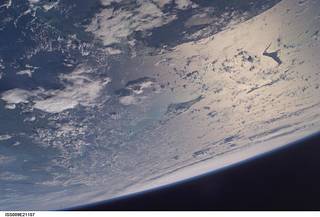
ISS009-E-21107 (1 September 2004) --- Astronaut Mike Fincke, aboard the International Space Station at an altitude of about 230 miles, took this photo of Hurricane Frances at about 9 a.m. Sept. 1 as the storm was centered about 800 miles east-southeast of West Palm Beach, Florida. The southern tip of the Florida peninsula and the Bahama islands are visible in the foreground of this image. At the time, Frances was a category 4 hurricane with winds of 140 mph and was moving west-northwest toward a possible landfall in Florida. iss009e21107
Summary
ISS009-E-21107 (1 September 2004) --- Astronaut Mike Fincke, aboard the International Space Station at an altitude of about 230 miles, took this photo of Hurricane Frances at about 9 a.m. Sept. 1 as the storm was centered about 800 miles east-southeast of West Palm Beach, Florida. The southern tip of the Florida peninsula and the Bahama islands are visible in the foreground of this image. At the time, Frances was a category 4 hurricane with winds of 140 mph and was moving west-northwest toward a possible landfall in Florida.
The International Space Station (ISS) is a habitable space station in low Earth orbit with an altitude of between 330 and 435 km (205 and 270 mi). It completes 15.54 orbits per day. Its first component launched into orbit in 1998, and the ISS is now the largest man-made body in low Earth orbit. The ISS consists of many pressurized modules, external trusses, solar arrays, and other components. ISS components have been launched by Russian Proton and Soyuz rockets, and American Space Shuttles. The ISS is a space research laboratory, the testing ground for technologies and systems required for missions to the Moon and Mars. The station has been continuously occupied for 16 years and 201 days since the arrival of Expedition 1 on 2 November 2000. This is the longest continuous human presence in low Earth orbit, having surpassed the previous record of 9 years and 357 days held by Mir. The station is serviced by a variety of visiting spacecraft: the Russian Soyuz and Progress, the American Dragon and Cygnus, the Japanese H-II Transfer Vehicle, and formerly the Space Shuttle and the European Automated Transfer Vehicle. It has been visited by astronauts, cosmonauts and space tourists from 17 different nations.
Tags
Date
Source
Copyright info







































